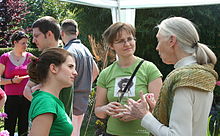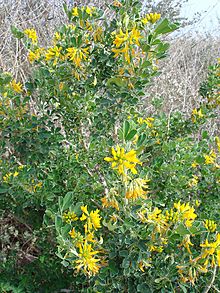Bonobos are just wonderful
http://www.janegoodall.org/bonobos-wonderful*
The Bonobo in All of Us
http://www.pbs.org/wgbh/nova/nature/bonobo-all-us.html*
"Bonobo chimpanzee" wiki subject page at WUaS -
http://worlduniversity.wikia.com/wiki/Bonobo_chimpanzee
"Primatology" wiki subject page at WUaS -
http://worlduniversity.wikia.com/wiki/Primatology
*
Just came across this new insight into common chimpanzee violence recently in the "Jane Goodall" Wikipedia entry ...
Jane Goodall, Primate research, Technology use, Vegetarianism? / nonharming? among common chimpanzees?
From Wikipedia:
...
Goodall's research at Gombe Stream is best known to the scientific community for challenging two long-standing beliefs of the day: that only humans could construct and use tools, and that chimpanzees were vegetarians.[17] While observing one chimpanzee feeding at a termite mound, she watched him repeatedly place stalks of grass into termite holes, then remove them from the hole covered with clinging termites, effectively “fishing” for termites.[18] The chimps would also take twigs from trees and strip off the leaves to make the twig more effective, a form of object modification which is the rudimentary beginnings of toolmaking.[18] Humans had long distinguished ourselves from the rest of the animal kingdom as "Man the Toolmaker". In response to Goodall's revolutionary findings, Louis Leakey wrote, "We must now redefine man, redefine tool, or accept chimpanzees as human!".[18][19][20]
In contrast to the peaceful and affectionate behaviours she observed, Goodall also found an aggressive side of chimpanzee nature at Gombe Stream. She discovered that chimps will systematically hunt and eat smaller primates such as colobus monkeys.[17] Goodall watched a hunting group isolate a colobus monkey high in a tree, block all possible exits, then one chimpanzee climbed up and captured and killed the colobus.[20] The others then each took parts of the carcass, sharing with other members of the troop in response to begging behaviours.[20] The chimps at Gombe kill and eat as much as one-third of the colobus population in the park each year.[17] This alone was a major scientific find which challenged previous conceptions of chimpanzee diet and behaviour.
But perhaps more startling, and disturbing, was the tendency for aggression and violence within chimpanzee troops. Goodall observed dominant females deliberately killing the young of other females in the troop to maintain their dominance,[17] sometimes going as far as cannibalism.[18] She says of this revelation, "During the first ten years of the study I had believed […] that the Gombe chimpanzees were, for the most part, rather nicer than human beings. […] Then suddenly we found that chimpanzees could be brutal—that they, like us, had a darker side to their nature."[18] She described the 1974–1978 Gombe Chimpanzee War in her memoir, Through a Window: My Thirty Years with the Chimpanzees of Gombe. Her findings revolutionised contemporary knowledge of chimpanzee behaviour, and were further evidence of the social similarities between humans and chimpanzees, albeit in a much darker manner.
Goodall also set herself apart from the traditional conventions of the time by naming the animals in her studies of primates, instead of assigning each a number. Numbering was a nearly universal practice at the time, and thought to be important in the removal of one's self from the potential for emotional attachment to the subject being studied. Setting herself apart from other researchers also led her to develop a close bond with the chimpanzees and to become, to this day, the only human ever accepted into chimpanzee society. She was the lowest ranking member of a troop for a period of 22 months.
Among those that Goodall named during her years in Gombe were:[21]
- David Greybeard, a grey-chinned male who first warmed up to Goodall;[22]
- Goliath, a friend of David Greybeard, originally the alpha male named for his bold nature;
- Mike, who through his cunning and improvisation displaced Goliath as the alpha male;
- Humphrey, a big, strong, bullysome male;
- Gigi, a large, sterile female who delighted in being the "aunt" of any young chimps or humans;
- Mr. McGregor, a belligerent older male;
- Flo, a motherly, high-ranking female with a bulbous nose and ragged ears, and her children; Figan, Faben, Freud, Fifi, and Flint;[23][24]
- Frodo, Fifi's second oldest child, an aggressive male who would frequently attack Jane, and ultimately forced her to leave the troop when he became alpha male.[25]
Jane Goodall Institute
In 1977, Goodall established the Jane Goodall Institute (JGI), which supports the Gombe research, and she is a global leader in the effort to protect chimpanzees and their habitats.
*
At a talk for his new book "Waging Peace" by David Hartsough at San Francisco Friends' Meeting (Quaker) in the "second hour" yesterday (http://www.peaceworkersus.org/books/bookschedule/), I asked an out of the box question about David's thinking, for peace studies, and about ways in which we humans can learn from common chimpanzees and Bonobo chimpanzees about nonharming. I asked something to the effect:
"As an out of the box question, in what ways can humans learn about nonviolence/nonharming more explicitly from Pan troglodytes (chimps) and Pan paniscus (Bonobo) - I didn't mention out of 376 primate species - than we have already, given that chimps can be violent, aggressive, and seem to practice primitive forms of war (also not mentioning Jane Goodall's above primatological observations that dominant chimp females have been observed to kill the infants of other non-dominant females to maintain their status), and Bonobo chimps are matriarchal, egalitarian, very sexual and seemingly nonharming toward each other (they do kill small rodents however for example); how might peace studies and the peace movement, and humans in general, learn from this primatological research, and why haven't we done so significantly already, since say the 1960s, when the implications of such research for peace among homo sapiens started to become part of a wider societal discourse, with primatological writers such as, for example, Jane Goodall for chimps, and Frans de Waal for Bonobos, sharing what they've learned about our closest genetic relatives in the field; given that Quakers teach peace, and that humans learn, how can we bring lessons from these two species especially into peace studies much more fully, and significantly lessen human violence?"
*
...

.jpg)



